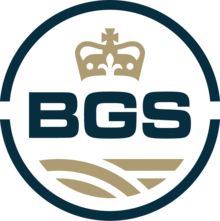 | |
| Abbreviation | BGS |
|---|---|
| Formation | 1835 |
| Legal status | Government organisation |
| Purpose | Geoscience |
| Location |
|
| Region served | United Kingdom |
| Director | Karen Hanghøj |
| Parent organisation | UK Research and Innovation (via NERC) |
| Budget | £57m around 50% from the Science Budget |
| Website | www |
The British Geological Survey (BGS) is a partly publicly funded body which aims to advance geoscientific knowledge of the United Kingdom landmass and its continental shelf by means of systematic surveying, monitoring and research.
The BGS headquarters are in Keyworth, Nottinghamshire, England. Its other centres are located in Edinburgh, Wallingford, Cardiff and London. The current tagline of the BGS is: Understanding our Earth.
History and previous names
The Geological Survey was founded in 1835 by the Board of Ordnance as the Geological Survey of Great Britain, under directorship of Henry De la Beche. This was the world's first national geological survey. It remained a branch of the Ordnance Survey for many years. In 1965, it was merged with the Geological Museum and Overseas Geological Surveys, under the name of Institute of Geological Sciences. On 1 January 1984, the institute was renamed the British Geological Survey (and often referred to as the BGS), a name still carried today. Since 1835, there have been 20 directors of the survey. In 2019, Karen Hanghøj was the first woman appointed to lead the survey.
From the 1860s, the survey in Scotland operated under the identity of the Geological Survey of Scotland.
Starting in 1975, female officers of the survey no longer had to resign upon getting married.
Competences

The BGS advises the British government on all aspects of geoscience, as well as providing impartial advice on geological matters to the public, academics and industry. BGS is a component body of UK Research and Innovation which "works in partnership with universities, research organisations, businesses, charities, and government to create the best possible environment for research and innovation to flourish". The core outputs of the BGS include geological, geophysical, geochemical and hydrogeological maps, descriptions and related digital databases. Scientists at the BGS produced the first comprehensive map of African groundwater reserves. One of the key strategic aims for the next decade is to complete the transition from 2-D mapping to a 3-D modelling, to understand the 'architecture' of the subsurface. The current five-year strategy identifies four key priorities for the BGS: 'maps and models for the 21st century; a more secure energy transition; improved water security; and living with geological hazards'. The BGS has an annual budget of £57 million, about half of which comes from the government's science budget, with the remainder coming from commissioned research from the public and private sectors.
Northern Ireland
The Geological Survey of Northern Ireland (GSNI) is part of Northern Ireland's Department for the Economy (DfE). The British Geological Survey provides staff, under contract to DfE, for the GSNI.
See also
References
- "About BGS – Governance". British Geological Survey. Retrieved 4 June 2023.
- "BGS Strategy 2023 to 2028".
- "Institute of Geological Sciences".
- "Our history".
- Press, B. G. S. (3 July 2019). "Karen Hanghøj named Director of the British Geological Survey".
- "Geological Survey history — Scotland". British Geological Survey. Retrieved 4 June 2023.
- Rod Bowie, Records Centre Manager, National Geological Records Centre, British Geological Survey, Keyworth (January 1995). "Freedom and Equality-Women in Geology". Geological Society, London, Special Publications. 97 (1). British Geological Survey, Natural Environment Research Council: 117–125. doi:10.1144/GSL.SP.1995.097.01.15. S2CID 129574405. Retrieved 23 May 2018.
{{cite journal}}: CS1 maint: multiple names: authors list (link) - Scholl, Adam (12 June 2012). "Map Room: Hidden Waters". World Policy Journal. Archived from the original on 3 October 2015. Retrieved 19 December 2012.
- "BGS maps out priorities with five-year strategy". B. G. S. 11 May 2023. Archived from the original on 2 October 2023.
- "GSNI". GSNI / BGS. Retrieved 4 June 2023.
External links
- Official website

- BGS Earthwise: The digital publication channel for the British Geological Survey
- BGS Annual Report
- BGS International
- Landslides at BGS.ac.uk